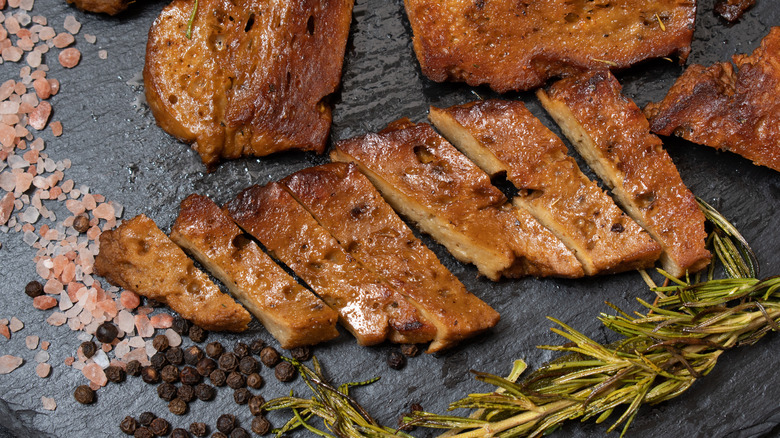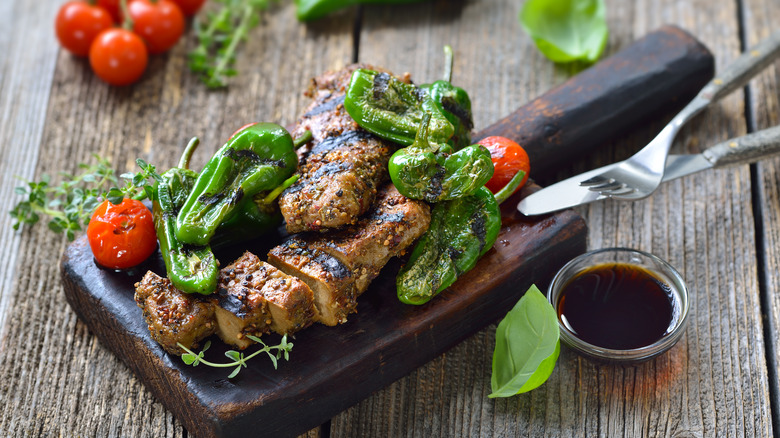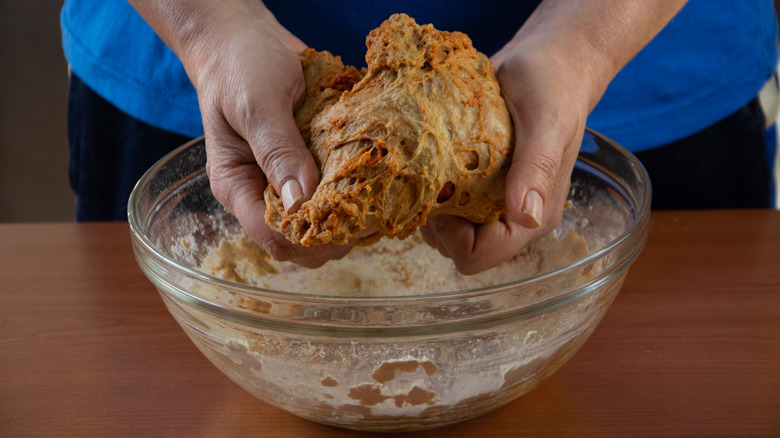What Is Seitan And How Do You Cook With It?
Tofu, tempeh, lentils, and beans are among the most popular vegan proteins to choose from, but few resemble the texture of meat and animal protein better than seitan does. Pronounced as say-tawn or say-tan, seitan is made from a dough of wheat flour and water that is rinsed of all its starch until only a spongy ball of gluten remains. This is why it is also known as wheat protein, wheat gluten, wheat meat, or simply as gluten because seitan is just that — pure wheat gluten.
Since it is isolated gluten, seitan has a chewy, meaty texture and a fairly mild flavor that is similar to that of portobello mushrooms or neutral chicken. Although it can have more bite when spices and condiments are kneaded in, seitan's greatest advantage is its texture and ability to absorb other flavors. This makes it essentially a blank canvas to cook with. Plus, seitan is also versatile in how it is cooked: It can be grilled on a barbecue like in this vegan seitan negimaki recipe, or sliced into strips and stir-fried or pan-fried on the stove. It even fares well in liquids and can be deep-fried — the possibilities are endless.
Origin and ways to cook seitan
According to some, the origin of seitan can be traced back to sixth-century China, where Buddhist monks who primarily follow a vegetarian diet sought an alternative to animal meat. They found that mian jin (the Chinese term for the process of isolating wheat gluten) gave rise to a very stretchy dough that mimicked the texture of meat incredibly well. As such, the use of seitan in cooking has historically been as a plant-based alternative to meat.
Over the years, seitan has also earned the moniker of fake meat and a certain reputation for passing off as chicken. When breaded, dredged, and dunked into hot oil, seitan can make plant-based deep-fried chicken and chicken nuggets. It can even be seasoned and turned into a deep-fried chicken burger. When in doubt, however, it's good to remember that seitan can be cooked in any recipe that calls for meat-based protein; roll it tightly to make sausages, shred it to replicate pulled pork, or marinate and cook it as a thick steak. It can even be turned into plant-based bacon!
While Gordon Ramsay uses alternative ingredients to make his vegan BLT (crumbled tofu and rice paper), flattened strips of seitan will do an equally fine job. Once you get the hang of it, you'll find that seitan can be used on its own and can be added to practically any dish that needs a bit of protein — think sandwiches, wraps, salads, grilled skewers, noodles, and the like.
What to know about seitan before you cook it
There are a few things to keep in mind before you start cooking with seitan. Unless you're making seitan from scratch, store-bought versions are typically ready to eat, which means they only need to be heated — not cooked. This is important when you're substituting seitan into a recipe as you might need to reduce its cook time. Seitan also tends to dry out, so it's best to either give it only a quick flash of heat or use it in liquid-based dishes where it truly shines.
Another thing to pay attention to is how you flavor the protein. Seitan is inherently bland, so you may be tempted to load it with seasonings. But before you do so, always taste it first. You might find that your store-bought seitan is already flavored and doesn't require much else, or it only needs a little something to give it some oomph.
Tasting it before cooking will also give you an idea of how much (if any) salt to add; some versions contain high amounts of sodium from soy sauce used to flavor it. Lastly, while gluten is excellent for those allergic to soy-based proteins like tofu and tempeh, it isn't suitable for anyone sensitive to gluten – it can trigger severe reactions if you have celiac disease or gluten intolerance (via Healthline).



